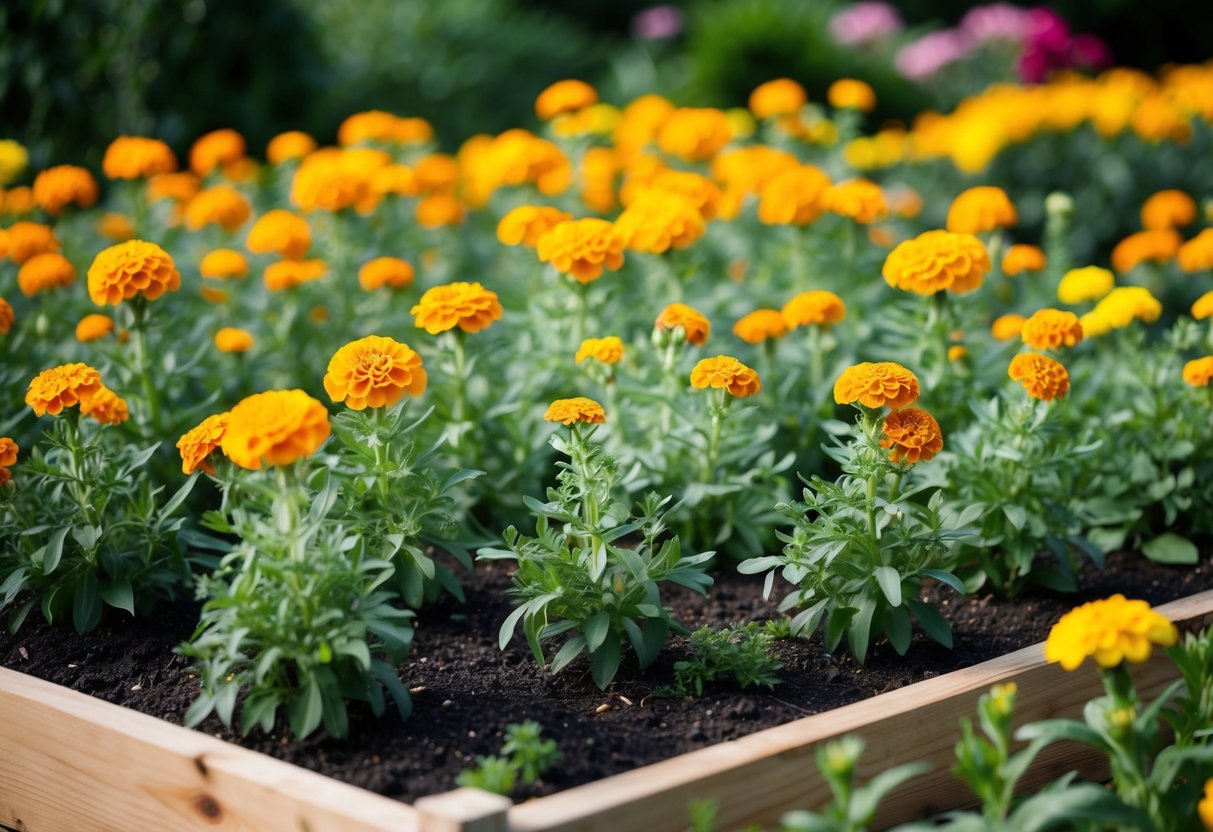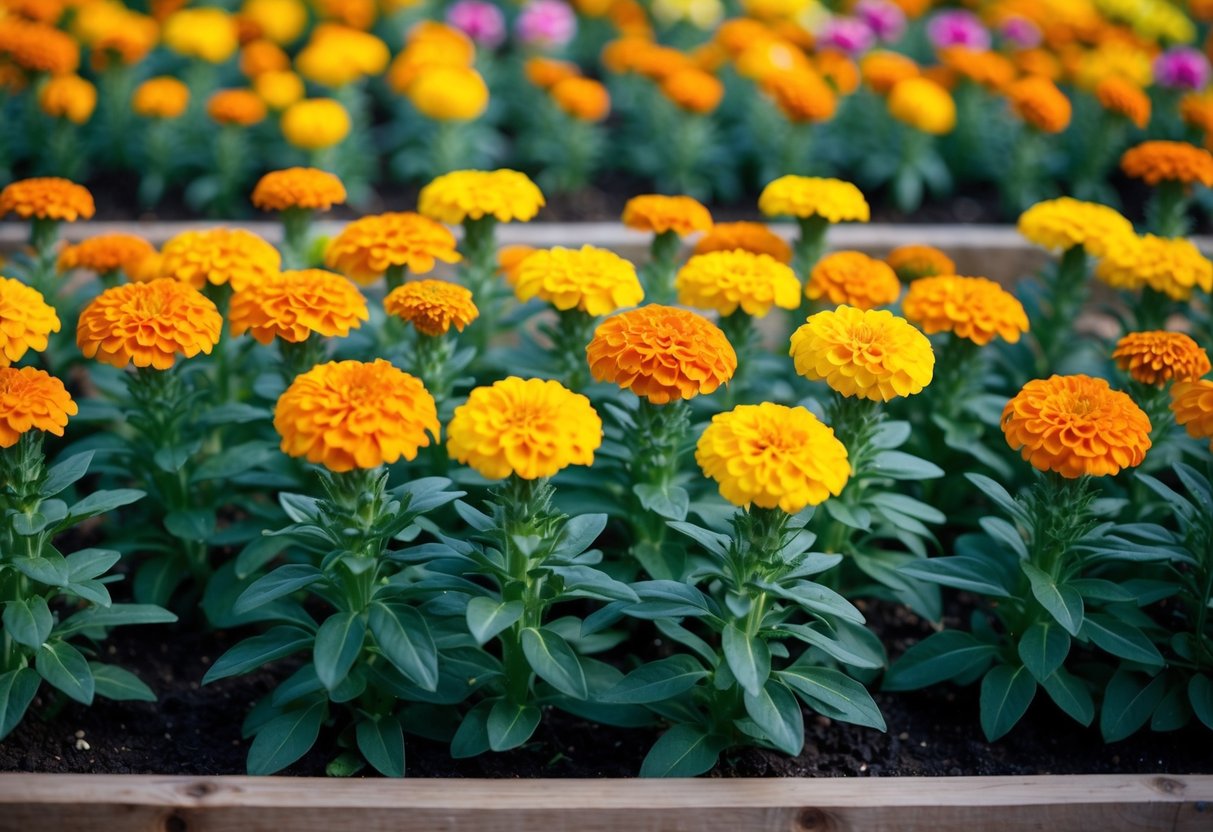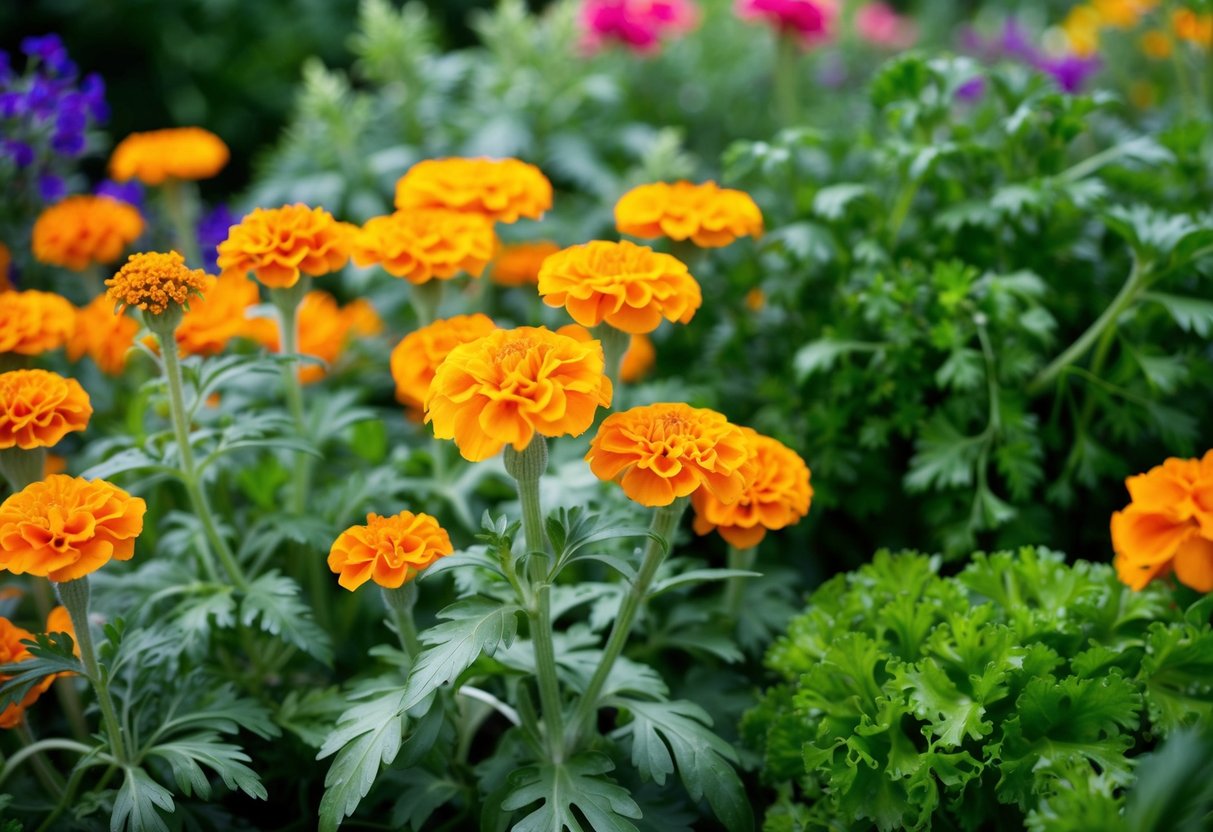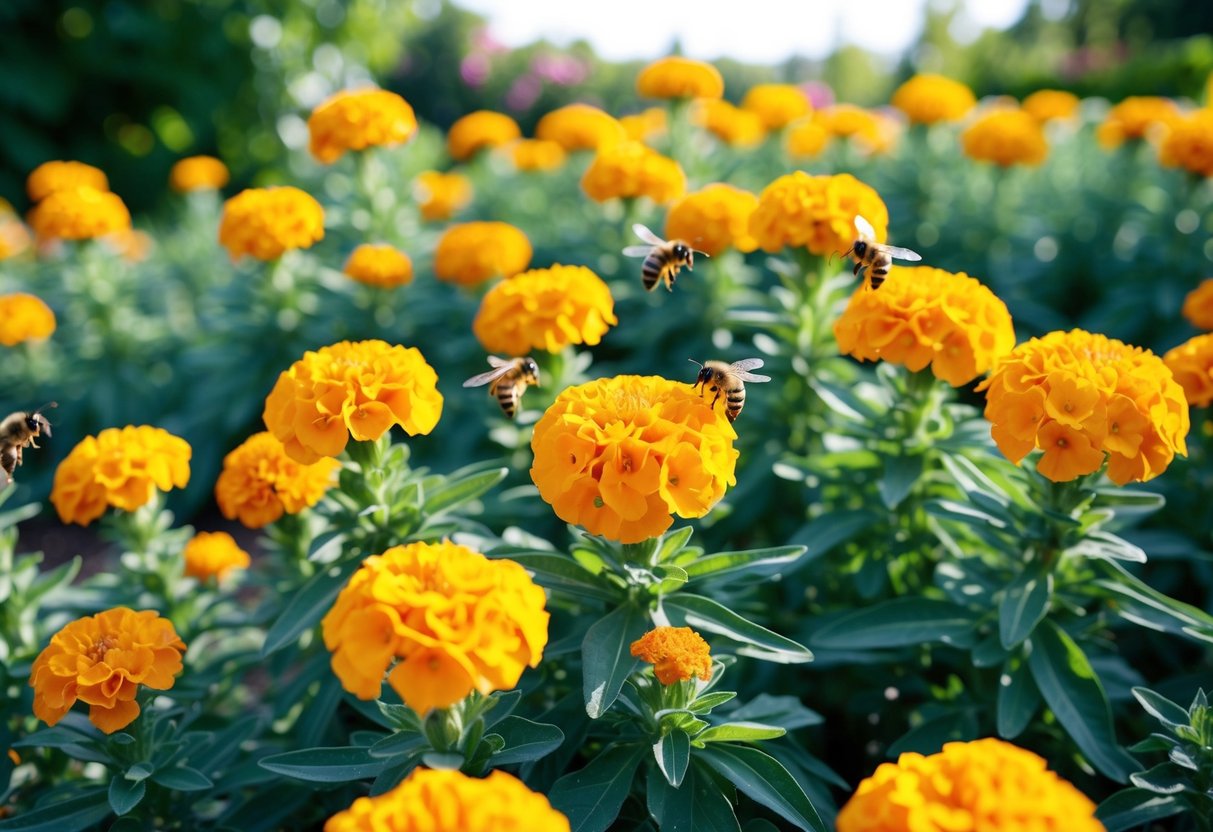Can You Plant Marigolds Close Together? Tips for a Thriving Garden
Marigolds are a popular choice for gardeners because of their vibrant colors and ability to deter pests. You can plant marigolds close together, but make sure they have enough room to grow and don’t compete for resources. Too close might lead to limited air circulation, which can cause problems like mold.

In companion planting, marigolds are great to pair with vegetables in your garden. They can help protect crops from harmful insects and improve the health of your plants. For example, garlic chives are a great plant to mix with marigolds for a healthy garden.
Marigolds don’t just add beauty to your garden; they play an important role in boosting your vegetable garden’s success. Consider spacing marigolds about a foot apart to get the most benefits without overcrowding. This balance helps ensure your garden stays healthy and productive.
Benefits of Planting Marigolds in Your Garden

Marigolds are great for your garden. They not only add vibrant color but also offer many benefits. Key advantages include pest deterrence, attracting helpful insects, and improving soil health.
Pest Deterrent and Companion Planting
Marigolds act as a natural pest deterrent. They help keep harmful insects away from your vegetables and other plants. By planting marigolds alongside your vegetables, you create a protective boundary. This strategy is a part of effective companion planting techniques. Marigolds work well with tomatoes, peppers, and cucumbers, among others.
Their strong scent deters pests like aphids and beetles. You don’t need chemicals when marigolds are on your side. Their presence reduces the need for pesticides, making your garden more eco-friendly. Plant them near sensitive plants to let their scent work its magic.
Attraction of Beneficial Insects and Pollinators
Marigolds can attract beneficial insects such as ladybugs and hoverflies. These insects help control pests by feeding on them. Attracting these creatures boosts natural pest control in your garden. Marigolds are also excellent for drawing pollinators like bees and butterflies. Pollinators play a crucial role in the growth and reproduction of plants.
Plant marigolds in clusters to attract more insects. Bees love them, which means your vegetable blooms get more attention. This can lead to a better harvest. Make sure to include different types and colors of marigolds to appeal to a wide range of pollinators.
Soil Health and Nematode Control
Beyond fighting pests, marigolds improve soil health. They are known for their ability to control parasitic nematodes. These tiny worms can damage plant roots, especially root-knot nematodes. Marigolds release natural chemicals into the soil that help suppress nematode populations. Plant them near crops like strawberries and carrots that are prone to nematode damage.
This not only helps protect your plants but also enhances overall soil quality. With marigolds, you fortify the ground without harsh chemicals. Use marigolds as a protective ground cover to keep your soil rich and free of unwanted pests.
Spacing Recommendations for Marigolds

Giving your marigolds enough space helps them grow healthy and vibrant. Proper spacing depends on the type of marigold and ensures they get enough sunlight and nutrients, while preventing overcrowding.
Optimal Spacing for Growth
For the best results, consider the type of marigold you are planting. African marigolds are the tallest variety and require more space. Plant them about 10-12 inches apart to allow for their height, which can reach up to three feet. This spacing gives them room to spread out and ensures they receive full sun, which is crucial for healthy blooms.
French marigolds, on the other hand, are smaller and can be spaced closer together. A distance of 8-10 inches apart works well for these varieties. This spacing suits their growth habits, letting them thrive in well-drained soil while still getting plenty of sunlight.
Avoiding Overcrowding
Overcrowding can lead to issues like stunted growth and poor flowering. It also increases the risk of disease due to limited air circulation. Make sure to avoid planting marigolds too close together. This is especially important for African marigolds, which need ample room for their tall and bushy growth.
In containers, use pots that are at least 10 inches across for African marigolds. French varieties, particularly dwarf types, can do well in smaller pots. With thoughtful spacing, your marigolds will flourish, providing lush and colorful blooms.
Companion Plants for Marigolds

Pairing marigolds with the right plants enhances your garden’s health and beauty. They help repel pests and enrich the soil. Learn how vegetables, herbs, and flowers can form a perfect partnership with marigolds.
Vegetables and Herbs as Companions
Marigolds work well with many vegetable plants. Tomatoes and marigolds make a great duo. Marigolds help keep pests like nematodes away from tomatoes. Cucumbers also enjoy their company, as marigolds deter beetles that trouble cucumbers.
Lettuce thrives next to marigolds, benefiting from their pest control abilities. Consider adding herbs like basil, thyme, and sage to your marigold garden. These herbs benefit from marigolds’ protective nature while bringing flavor to your dishes. Peppers also perform well with marigolds, thanks to the reduced pest issues.
Floral Companions and Color Harmony
Beyond vegetables and herbs, marigolds look stunning with certain flowers. Geraniums are excellent floral companions. They complement marigolds with similar pest-repelling traits and vibrant colors. Adding roses near marigolds can enhance garden aesthetics and protect roses from common pests.
For a touch of elegance, consider lavender, which pairs well with marigolds. Its purple hue creates a beautiful contrast against marigolds’ bright colors. Choosing the right companion plants for marigolds can create a balanced and colorful garden filled with beneficial relationships. Look for complementary colors to make your garden visually appealing and healthy.
Dealing with Common Pests and Diseases

Keeping your marigolds healthy requires you to tackle common pests and prevent diseases. Aphids, whiteflies, and spider mites are among the common pests. Understanding how to manage these issues can keep your garden thriving.
Identifying and Managing Pest Infestations
Marigolds often attract pests like aphids, whiteflies, and spider mites. Aphids are tiny green or black insects that suck sap from the plants, causing leaves to yellow. You can find them clinging to stems and undersides of leaves. Spider mites are even smaller and cause a speckled appearance on leaves. A strong spray of water can often remove these pests, and insecticidal soap is another effective option.
Slugs, snails, and cabbage worms also love marigolds. These pests chew on leaves and stems, leaving noticeable holes. Setting traps or using organic slug bait can keep these invaders at bay. Flea beetles and their small, round holes can be controlled with neem oil or row covers. Watch your plants closely and act quickly to stop these pests from causing more damage.
Preventing Disease and Maintaining Healthy Plants
Diseases such as Alternaria leaf spot can attack marigolds, causing brown spots with yellow rings on leaves. Keeping plants well-spaced can prevent such diseases by ensuring good air circulation.
It’s also important to water at the base of the plant to keep foliage dry, reducing the chance of diseases. Overcrowding plants might increase stress and invite more problems. Rotate crops regularly to keep soil fresh and lessen disease risks. Regularly removing dead or diseased foliage is crucial to maintaining healthy plants. Finally, avoid overhead watering to minimize moisture on leaves, which can lead to rot and fungal problems.
Cultivating a Resilient and Sustainable Garden

Creating a resilient and sustainable garden involves smart planting techniques and caring practices. You can enhance biodiversity and promote the long-term health of your garden by using interplanting and adopting sustainable gardening methods.
Interplanting Strategies for Biodiversity
Interplanting, also known as intercropping, involves growing multiple plant species together to enhance garden biodiversity. By pairing compatible plants, you can create a more resilient ecosystem. For example, marigolds are excellent companion plants for vegetables because they attract beneficial insects and repel harmful pests. This natural pest control reduces the need for chemical interventions.
Including a variety of drought-tolerant plants in your garden can further bolster resilience. These plants require less water, making them an environmentally friendly choice. Consider integrating species like lavender and succulents, which thrive in dry conditions and conserve water.
Interplanting not only supports biodiversity but also boosts your yields and strengthens plant resistance to diseases, creating a more balanced garden environment.
Best Practices for Long-Term Garden Health
Maintaining a sustainable garden requires dedication to healthy soil practices and mindful resource use. Start by enriching your soil with organic matter, such as compost, which improves soil structure and nutrient content. This healthy soil foundation supports strong plant growth and enhances resilience to pests and diseases.
Regular mulching helps retain moisture, reduce erosion, and suppress weeds. Using local and natural materials for mulch aligns with sustainable practices, conserving water and promoting garden health.
To keep your garden thriving, practice crop rotation. Rotating crops prevents soil depletion and interrupts pest and disease cycles. Additionally, encourage pollinators by planting a variety of flowering plants, which increases biodiversity and helps your garden prosper.







